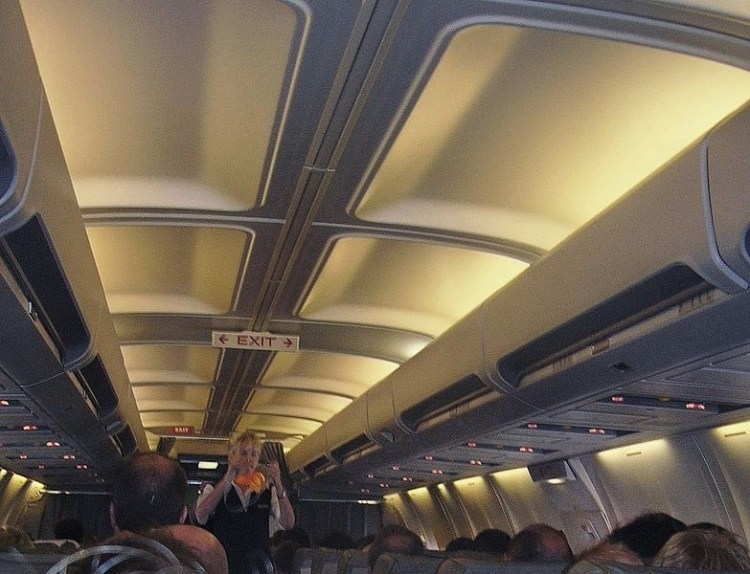
Attribution of photo Lufthansa attendant giving safety briefing
Dr Cliff Reid recently wrote an article about the concept of a resuscitation safety room officer, like a lifeguard. RESUS ROOM LIFE GUARD
Dr Andy Buck wrote on a similar concept.RESUS ROOM SAFETY OFFICER
They inspired me to write this…on a recent commercial flight.
This is to be delivered before each RSI by the designated safety officer
“RSI safety briefing
Hello
this is your resuscitation room safety officer speaking
You are shortly about to perform a rapid sequence intubation
This is the RSI safety briefing for that procedure.
Whilst you may have performed this procedure many times in the past, each one can be different so your attention to the briefing is greatly appreciated
By now your patient should be undergoing or about to under go preoxygenation, your airway equipment checked and ready and monitoring in place and recording.
I refer you to your RSI safety briefing card and checklist which you should take the time to peruse and complete prior to the procedure.
In the event of an airway emergency, ensure the patient and yourself are adequately placed into the position for maximal oxygenation and airway patency.
Oxygenation is your primary safety technique and it must be securely attained and maintained throughout the procedure
in the event of unexpected hypoxia, the monitor will alarm and the safety officer will announce the need for emergency oxygenation to occur. Please do so primarily via the standard mask technique offered to you. Do this before you do anything else
In the event that this fails or there is urgent need to deploy the secondary safety technique, then reach for your life airway device. It should be inserted into the patients mouth and rescue ventilation established. It may need to be manually inflated. ensure you insert the life airway device and attempt rescue ventilation prior to abandoning the procedure of RSI and exiting via the tertiary safety plan of a surgical airway.
In the event of need to exit the procedure urgently, ensure you are familiar with the nearest exit available to you and how to operate it, even if you are unable to see and need to perform the exit blindly.
There are only four exits to the RSI procedure
Face Mask ventilation and recovery
Establishment of orotracheal intubation
Establishment of supraglottic airway device
Establishment of tracheal access via the neck
Please familiarise yourself with each exit and the most suitable for your type of patient
There is no smoking permitted during this procedure and all personal electronic devices need to be switched off.
Thankyou for your attention and hope you have a pleasant and safe RSI
This is your resuscitation room safety officer speaking”
Can you come up with a better version? If so send in your suggested version and lets record a podcast of it! Write your own version , record a brief audio file of it and send it to me to post as a PHARM podcast!

I like it!
Does the RSI safety officer dress smart and blow into an ETCO2 detector to check working, like the simulated ‘manual inflation of lifejacket’ that air hostesses do?
why dont you and Daube record a KI version of the safety briefing and send it in!?
Not a bad idea, sadly he’s just headed off to Sth Georgia
A relief – I look shocking in a dress!
After the whole ‘airway topicalising’ thing, I am sure Casey thinks we are queer…
tim
The terrifying part is finding out I am Captain of the flight and that no this is not a bad ketamine dream 😀
Good work Minh, I reckon a safety person should be mandatory at all RSI!
Brilliant Minh!
to be honest Cliff, I was a bit skeptical about the safety officer concept, till during a recent commercial flight it suddenly dawned on me during the cabin safety briefing…its all about safety being incorporated into routine behaviour. Why do the airlines still do it..when we know most of us tune off? Its because even if only one or two passengers take on board the safety message, that might mean at least they make it out alive in an emergency!
Its the law of simplicity engineering, the law of the lowest denominator.
In medicine we dont like those laws because we think we are too clever for them, masters of our patients destiny.
But this is where I believe aviation can teach medicine. attention to simple safe behaviours and practices.
Exactly.
So….given anaesthetists/prehospital/EM docs propensity for gadgetry (to a degree), why not incorporate this as an in-built option on the monitor?
Big button ‘RSI’ then a 60s audio-video spiel from the RSI safety hostess whilst patient is pre-ox’d that would be true simplicity engineering…
There might even be an App for that. i will have a word with Siri
Your mind goes to strange places. Brilliant, but strange.
Will see what I can rustle up …. Too late to demo at SMACC? Is audience participation allowed in SimWars?
Tim, ,I am sitting typing this in the Adelaide hills! Its not as hot as I expected! Might pay you a visit on KI!
But yes this was the idea of proposing a competition for the best audio recording of a safety briefing for RSI..perhaps we could create an app or at least a download folks can use on their smartphone.
This could be a simple FOAMEd project that might have large impact for safety for occasional intubators..but really any one doing intubation.
of course its a bit of artistic fun..what soundtrack can you add to it to embellish? it might even be sung as a jingle?!
but there is a serious side to it and we might even be able to research its impact..a before and after observational study?
then why not it be built into a monitor…or even a VL system? To borrow another aviation engineering concept, the pilot uses an automated audio checklist during preflight checks..why not RSI?
its FOAMEd but not as we know it…yet
One other thing…
I presume we are flying with ‘tiger airways’ ?
Better still, build in audible verbal ‘pull out’ warning into monitor – hit the big RSI button on monitor as the sux hits, and then a bice calm voice announcing 30s drills … For extra finesse integrate with SpO2 ‘consider awakening’ ‘cut th bleedin’ throat’ etc
I know a few lasses who could do th voiceover…
Reblogged this on AmboFOAM and commented:
I love this briefing from Minh! The importance of checklists when carrying out high risk procedures like RSI cannot be overstated, and eventually I will get around to talking about it. In the meantime enjoy this pearl.
Love it, reblogged it! We seem to have a lot of wide eyed students floating around ambulances in green jumpsuits these days. Maybe I can hand them a little hat and a card to read from when they arrive at jobs. Just need some Musak to go with it…
Love this idea, have the safety officers been breathalysed drug tested before each flight……?
Hi team!
Safety announcement sounds great. Similar to when the cabin crew show the passengers, doors are here, here, and here….we should do the safety person is here (points to them), difficult airway kit is here and the surical (cutting) kit is here. Is everybody competent in their role. Control to the RSI operator, all quiet please.
I like the idea of a verbal check list built into the monitor.
When working with Cliff and other fantastic clinicans they seemed to listen and were happy with a brief of who, what and when things were going to happy when looking after critical care patients. Intersting when trying to do a safety brief amongst other people, with anaesthetists especiallly registrars they looked bored and dismissive. More senior clinicans I have found, appreciate a regular safety summary as to where we are and where we want to be with the care of the critically ill / injured patient we are looking after.
Not a bad ide that random breathalyser samples are taken from critical care clinicans. If it is acceptable in the nuclear, rail and air industries, why not health (in particular high risk interventions such as emergency & critical care).
Maybe a joint piece of work with the DOME project (London) to help design an ergonomic / himan factors positive resus bay / room.
Bruce
(Department of Emergency Medicine, Southampton University Hospital).